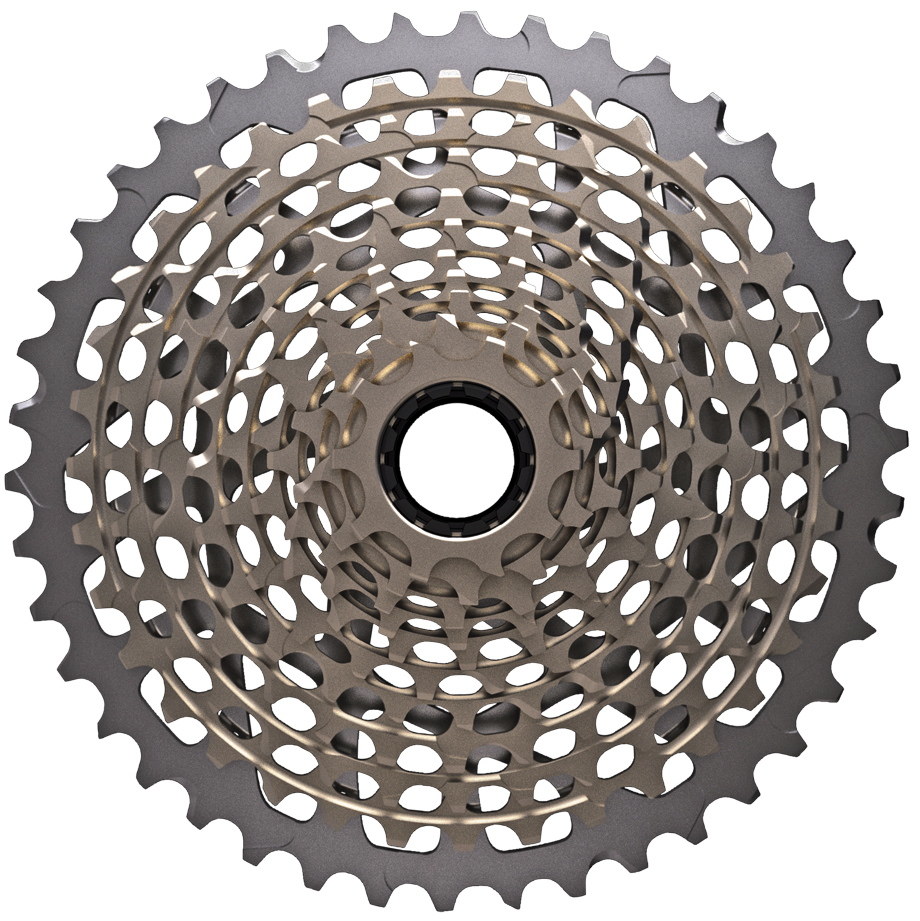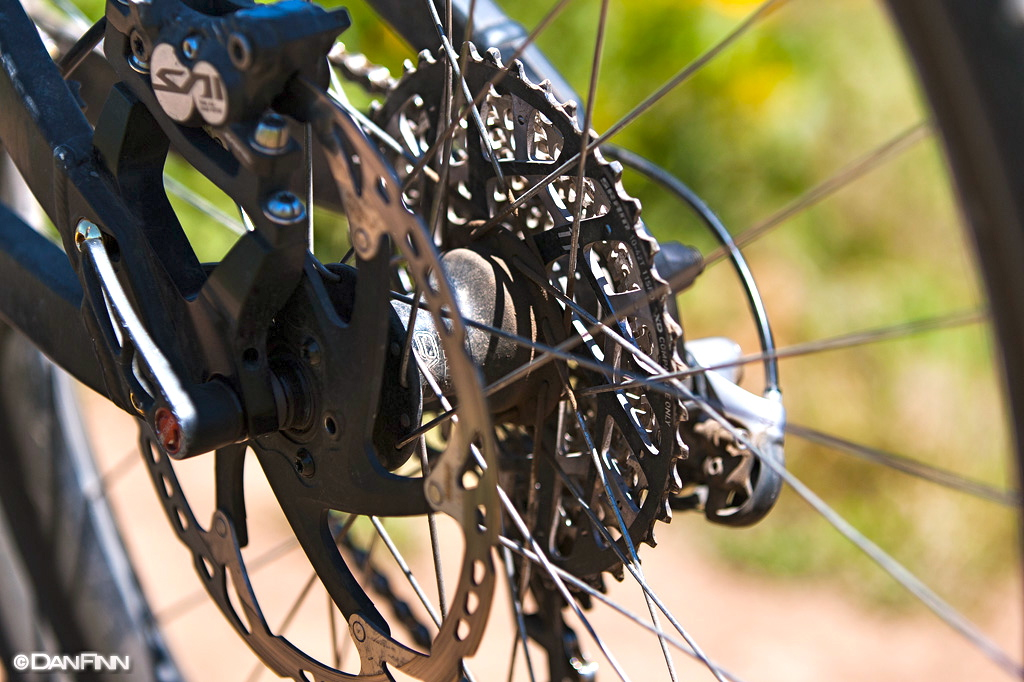Sram XX1 X-Dome Cassette and Drivetrain
The SRAM XX1 X-Dome Cassette builds on the modern marvel of design known as the XG1099 cassette. If you have never seen one of these X-Dome cassettes, they are worth checking out. They are cut from a single piece of steel and are basically hollow, with only a thin skeleton for the chain to ride on.

The design is super light: 260 grams, as opposed to 350 grams or more for a standard alloy carrier-style cassette. The hollow structure allows for awesome mud-shedding while the wheel is spinning, and the use of steel is known for extended durability compared to titanium cassettes of similar weights.

While I don’t have enough saddle time yet to vouch for the long-term durability of the 11-speed setup specifically, I have wrenched on plenty of SRAM Red and XX drivetrains that use the same materials and design, and can say unequivocally that the steel material choice lasts two to three times as long as equivalent weight cassettes built from Titanium (Shimano XTR). Considering the retail price on these things, that is a REAL, tangible improvement.
Shifting
The SRAM XX1 shifts smooth and positively (in line with all modern, top-level drivetrains) when soft pedaling and being smart with your shifts. But when you’re riding bikes in the mountains, your shifting can get more abrupt and rough—sometimes you need to quickly drop a number of gears for a short, punchy little climb, but you still need to fully load the pedals while shifting three cogs at a time.
The XX1 does this well—comparable to the X0 10-speed stuff I have ridden. It is a bit noisier than the Shimano XT drivetrain I am coming off of, but I’ll take a little noise for the accompanying benefits. Namely…
The large spread in the gearing (10-42) means that while shifting through the middle and low/easy end of the cassette range, I often only need to shift three clicks, where on my old 10-speed setup, I would need to shift four clicks. So the XX1 might be a little louder because it’s moving over a big jump in gears quicker, but the result is that you hit your desired gear earlier, and you can start pedaling hard sooner, which is certainly appreciated on the trail.
Hub Compatibility
The XX1 does require a different hub body for the cassette to ride on, but I have found that these hub bodies are pretty widely available. This is by no means an exhaustive list, but I know for sure that Mavic, DT Swiss, Specialized, Industry 9, Hope, and Loaded all have XX1-compatible parts to run XX1 on their wheels. Chris King is the one big exception for now, though my understanding is that they’re about a year out on their XX1 hub body.
Bottom Line
XX1 is SRAM’s flagship product line. It’s their lightest, highest-tech, best-performing offering, and it comes with a premium price tag to match. In my opinion, if that price tag doesn’t scare you off, then the XX1 build kit is really the only option out there right now for a 5-7” travel pedal bike.
The increased gear range, the quickness with which it allows you to hit your gears, the performance of the chainring and derailleur, and the incredible weight and durability of the drivetrain all speak to a very well thought-out and executed arrangement.
A number of the components and design features in the XX1 kit work so well that I am willing to bet that they’ll become the industry standards for all brands in the future.
SRAM has pretty much defined exactly what a purpose-built trail group really is, and has laid out a template for what it should look like going forward.
(You can now read Noah Bodman’s two-part review of the SRAM X1 drivetrain, a more affordable but still highly capable 11-speed system. If you’re not sure you’re ready to shell out for SRAM’s XX1 drivetrain, you should definitely check out the X1.)

nice review professor-
how about a 500 word essay on that roam? thing has been catching my eye more than kate upton doin’ the harlem shake…..
hey man, have to say that i am really happy with the roam thus far. it, at the very least, is a very solid trail bike. goes, stops, jumps. does all that jazz very well. the DH park is just opening up this weekend, so once i can put a bunch of laps on it there i will be prepping a real review, but super happy with it thus far.
How good is the ROAM!! Seeing yours has me tempted to invest in a CCDB air….
off topic again- but gear geaky all the same
how would you consider it rating as a smaller sibling to a park bike? -or in other words as a dh’rs 30 ish lb do everything trailbike? does it compare to a spitfire or knolly endo for trailability?
hey mb-
you are describing me, indeed. my build is about 32lbs right now with the ROAM, but that includes a 66 evo fork and 8″ saint breaks, so figure about 30 with a lyrik and 6″ xtr trails.
the frame is every bit as stiff laterally as my old TR250, and significantly more stiff than a stump jumper or some trail bike. it descends corners more like a park bike / free ride bike than an xc bike. I would think its pretty similar to a knolly chilcotin in that regard. I would say the ROAM pedals better and is way more fun descending than the OG endorphin. i have not ridden a new endorphin though, but i attribute that to the high-ish single pivot that the ROAM utilizes. the wheelpath is fairly rearward due to the pivot location, so the wheel does not hang up, but the chain line is straight thru the pivot, so it pedals very well.
there just isn’t much in SLC to justify a full blast DH bike unless you are looking to drive a couple hours, but there is plenty of rough high speed riding that a 160mm bike feels at home in. the ROAM is perfect for this.
hope that helps?
Great write up. Thinking my new ride may be 1 x 11. I have dabbled with 2 x10 on my wife’s bike but have been 3 x 9 for years. How big a deal is the transition from the 10 tooth across the cassette to 42, thinking the transition from hi speed through a depression (stream or what not) to steep up? Filling out order form, XT 3 x 10 or XO 1 x 11, expecting I’ll be real happy regardless.
hey jim,
it takes 3 pushes of the thumb while soft pedaling to get from a tall descending gear to a hill climbing gear. with a 3x setup, you would need to shift down 2 clicks in the front ring, and probably 2 or more thumb pushes to the rear derailleur to get to a hill climbing gear… so yeah, i would take the 1x setup all day long here.
hope that helps?
yup went for 1 x 11, looking forward to it thanks
Marshal, really great review of this thanks so much. best info out there on the XX1. I’ll order one to replace my 1×10 on cross country hardtail [21lbs]. I was cracking on the long steep climbs and race situations and had resigned myself to 2×10.
nice nigel,
I feel fairly confident that you would be quite happy with the range that the XX1 (and pending X01) groups offer. also of note that while the XX1 crank and ring are exceptional, they are not required, per se, and you can easily run the setup with your existing 1x setup without issue.
thanks and all the best!
how’s that roam review coming?
May I know wat size ROAM u using ?? Btw nice reviews
Cheers
Hey kelvin, it’s a large. Thanks.
Funny that all the comments here seem to reveal that we were all led by the frame :)
I’ll add another – still planning a review of that Roam? Now that you’ve had more time on it and hopefully logged several thousand feet at the Park as well as trail time, I’m curious how you’re liking it and how it compares for trail/park.
I’m currently on a Mojo HD, which works well, but 1) feels over built for a lot of trail riding 2) does a horrible job at small bump compliance – especially at the DH park, 3) can’t convert to 275 without losing travel, 4) but is a dream to jump and pedal. Not quite burley, but not quite racy. Considering the Roam as a better option for the burly trails and all day at the park where I rarely need a real DH bike (I ride CO mostly)
Are you missing a screw on your rear brake rotor?
I’m riding a new bike with XX1 and have a few days in with a 32t up front. In Fernie BC the rides are most often grinds to the top, preferably technical followed by a technical downhill. Maybe its just my 43 years but generally I find if my eyes are tearing I don’t need to shift to a small cog and accellerate. That being said I spend most of my time in the bigger cogs on the casette on the up and just use the smaller ones for that momentum boost on the dowhill to keep the pump. So now the point. I’m considering going down to a 28t up front not because I lack the legs but more so to keep the chain in the center of the casette for more of its use. Since I never use the bottom two cogs now this move would drop one “shift” and I’ll probably climb more in the 36t cog and use the 42t as a bail out. I am concerned even with a new bike about the extreme angles chain makes and the resulting wear on the ring, chain, and casette, both of which are pricey. Any comments on the durability over time and which cogs are the ones that give up? I’m betting its the 42t.